This infographic is a summary of our 28-page report highlighting successful projects from the Graduate Student Research & Education grant program. The report and infographic highlight the innovation and diversity of a portion of the Western SARE Graduate Student portfolio. Check out the summary of each project – featured or by state – and then download the full report for detailed stories
Featured Graduate Student Projects
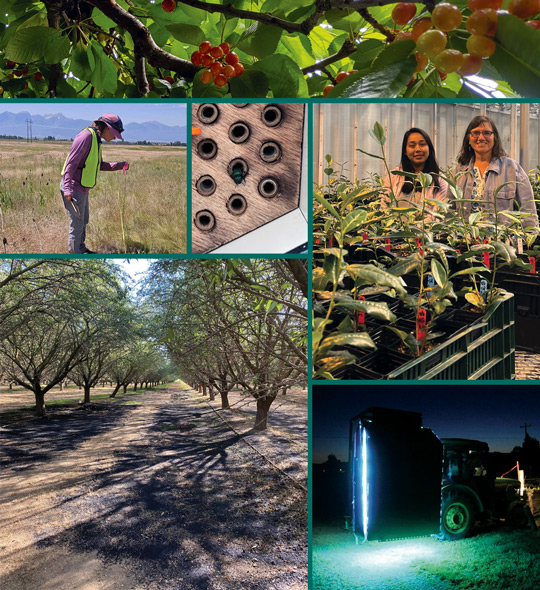
Beneficials for Cherries

Boosting Beneficial Insects in Oregon’s Cherry Orchards
Typically, when new cherry orchards are planted, farmers leave the ground under the trees bare or plant grass. Farmers also regularly apply chemicals to control insect pests. However, planting mixed cover crops that include flowering plants in new orchards may provide habitat for diverse beneficial invertebrates, some of which play key roles in pest control. Nearby natural habitats also harbor beneficials. To provide better understanding of how cover crops and natural habitats can support beneficial insects, graduate student Scott Mitchell examined how communities of beneficials are influenced by different cover crop blends, both in out of rotation orchards, newly planted orchards, and adjacent natural habitats.
Project GW21-225 Read more about this project
Photo: Out of rotation cherry orchard land with flowering cover crop blend. By Scott Mitchell
Propagating Tea Plants for the West
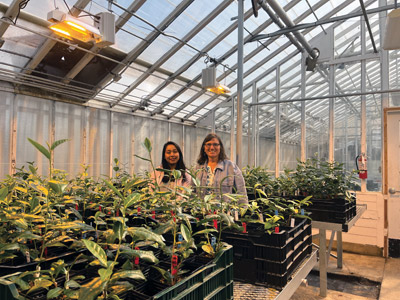
Tea is one of the most popular drinks in the world. In America, you can find it in more than 80% of households. Finding it in U.S. soil is another story. Tea is grown on less than 100 acres in America. “And honestly, there’s no reason tea crops can’t flourish throughout the nation, including the West,” said Srijana Shrestha, Washington State University. “The only barrier is lack of tea plant material and knowledge of tea plant propagation.” Shrestha and her major professor, Dr. Carol Miles, are working to change that. They are developing new techniques to propagate 14 tea varieties suited for Western climates.
Project GW24-013 Read more about this project
Photo: Srijana Shrestha (left) and Professor Carol Miles propagate tea varieties to test for Western climates. Courtesy of Washington State University
Biochar’s Benefits for Orchard Soils
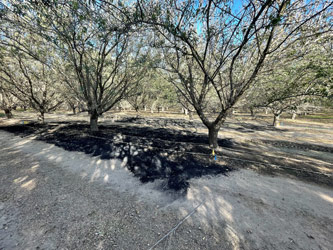
Measuring Biochar’s Benefits for Healthy Orchard Soils
To help California growers with new tools, the American Farmland Trust partnered with an almond grower, conservation districts, and the University of California at Merced to conduct a field demonstration project and experiment on the application of biochar and its effects on soil health. That project explored two biochar types applied at two rates and the effects on available inorganic nitrogen and greenhouse gas fluxes. After seeing positive results, graduate student Evelyn Perez-Agredano expanded the project to continue the on-farm research and add in a lab incubation study. She states that many almond growers in region are extremely interested in the data collected so far.
Project GW24-016 Read more about this project
Photo: experimental plots shortly after the application of biochar. By Elena Bischak
Using UV Light to Kill Powdery Mildew
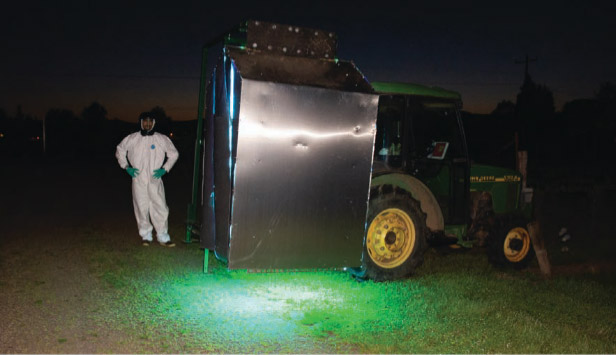
Photo: An early prototype of the light array used to kill powdery mildew in Oregon vineyards. By Walt Mahafee
Instead of relying solely on fungicides to control powdery mildew on winegrapes, growers may one day have an effective non-chemical option: light. Specifically, light in the form of spoor-killing ultraviolet UV-C radiation, delivered directly to the plant by a self-driving tractor moving through vineyard rows autonomously at night. As futuristic as that description sounds, the technology exists. Alexander Wong, Oregon State University worked with a unique group of collaborators, field testing the technology.
Project GW21-219 Read more about this project
Bison Grazing and Invasive Grasses
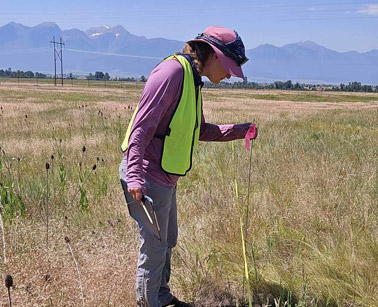
Learning How Bison Grazing Impacts Rangelands and Invasive Grasses
The Bison Range on the Flatheads Indian Reservation is the traditional homeland of the Confederated Salish and Kootenai Tribes. Here, the tribes have focused on land restoration, soil health improvement, and invasive species containment. Sarah Holloway, Salish Kootenai College graduate student, and her adviser were exploring research projects that would involve rangeland restoration. They realized that they first needed a baseline that would indicate soil health in various grassland microsites.The research explores soil organic carbon, infiltration rates, and bulk density. One site has a long history of bison grazing while the other nearby site is in an exclosure.
Project GW24-014 Read more about this project
Photo: Sarah Holloway measures vegetation to gather baseline data. By Sarah Holloway
Bees and Berry Pollination

Can Introducing Mason Bees Boost Berry Pollination?
When it comes to berry pollination throughout the West, honeybees are the biggest show in town. That can be a problem for pollination diversity and for farmers because honeybees aren’t always the best option for some crops. With help from local farmers, graduate student Miranda Jones and her advisor, Dr. Kelsey Graham, are introducing four species of mason bees to 16 berry fields in Oregon and Utah. The team designed and built hexagon-shaped nesting boxes filled with straw and drilled holes to mimic the structure mason bees like. Jones has tested the boxes in several fields already and is pleasantly surprised by early results.
Project GW24-008 Read more about this project
Photo: A mason bee peeks out of its nest. Photo by Miranda Jones.
All Graduate Student Projects By State
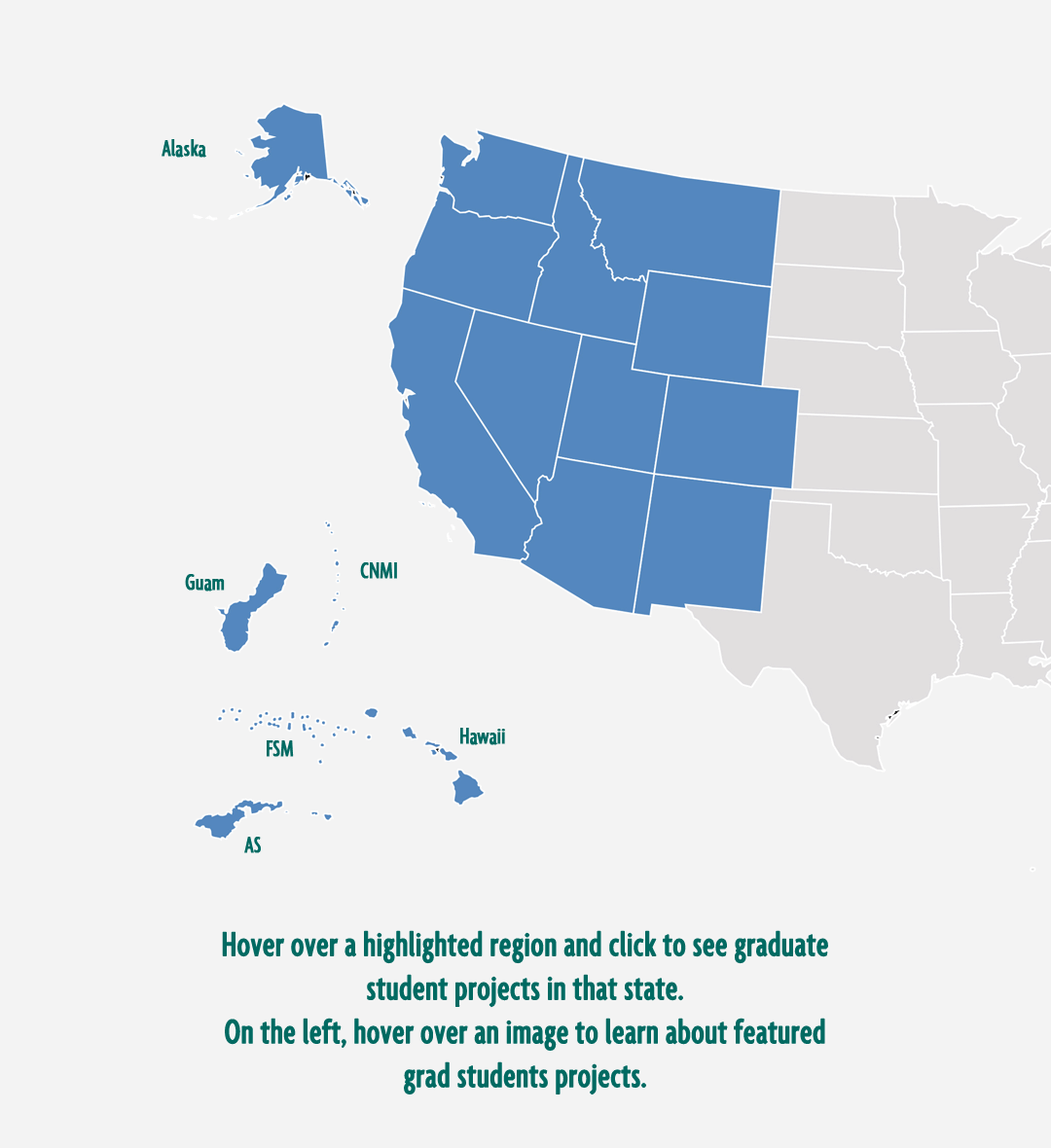
Compost and Rangelands
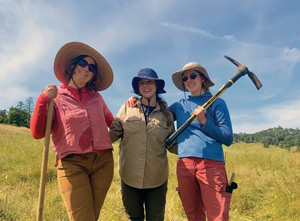
Impacts of Compost Application on the Drought Resiliency of Rangeland
Severe droughts pose threats to California’s rangelands. A previously funded project found that compost amendments provide benefits to soils and forage productivity, including greater resilience to drought. However, there are potential limitations to applying compost amendments to rangeland soils, and research thus far has demonstrated mixed results. Before implementing compost amendments on a large-scale basis, ecological effects and economic benefits/costs must be better understood. University of California, Davis, graduate student Ava-Rose Beech is collaborating with Farm Adviser Scott Oneto by using his field sites to assess how compost applications impact soil microbial abundance and soil microbial community composition and to investigate the potential of compost applications to improve resilience to drought on rangelands.
Project GW23-254 Read more about this project
Photo: Left to right: Claire Kisliuk, Alyssa Flores, Ava-Rose Beech on a range work day. By Ava-Rose Beech
Boosting Beneficials in Cherries

Boosting Beneficial Insects in Oregon’s Cherry Orchards
Typically, when new cherry orchards are planted, farmers leave the ground under the trees bare or plant grass. Farmers also regularly apply chemicals to control insect pests. However, planting mixed cover crops that include flowering plants in new orchards may provide habitat for diverse beneficial invertebrates, some of which play key roles in pest control. Nearby natural habitats also harbor beneficials. To provide better understanding of how cover crops and natural habitats can support beneficial insects, graduate student Scott Mitchell examined how communities of beneficials are influenced by different cover crop blends, both in out of rotation orchards, newly planted orchards, and adjacent natural habitats.
Project GW21-225 Read more about this project
Photo: Cover crops may be one way to boost beneficial insect populations that can provide natural pest control for cherry growers. By Scott Mitchell
IPM Adoption in Pears

Breaking the Barriers to IPM Adoption in Wenatchee Pears
In Washington’s Wenatchee Valley, which produces about 40 percent of the nation’s pears, broad-spectrum, calendar-based insecticide sprays remain the norm. IPM hasn’t been widely adopted, despite the fact that in recent qualitative interviews 80% of growers said conventional management practices for pear psylla are not effective and 60% said biological control is effective and important. Molly Sayles, Washington State University, conducted those interviews and additional surveys to document growers’ feelings about IPM and identify their roadblocks to adopting IPM practices. She’s now working to help growers in the valley overcome those roadblocks – which are plentiful.
Project GW23-245 Read more about this project
Photo: Having local IPM adopters speak to grower audiences is helping promote IPM practices. By Cody André
EPM and Values-Driven Farming
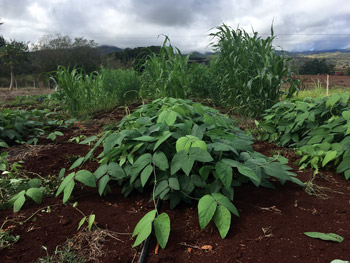
Hawaii Research Examines
Ecological Pest Management and Values-Driven Farming
Much agricultural research measures success in terms of higher yields or profits, but a new project is looking at a third dimension of success: values.“A lot of farmers make the transition to organic partially for commercial reasons, but it’s also a values-driven decision,” said Ben Wiseman, University of Hawaii. Wiseman is exploring that third dimension of success with sweet potato farmers. They are testing nematode-suppressing cover crops and a weevil-suppressing botanical pesticide. Both are less foolproof and more variable than synthetic chemical pesticides and may require more work on the grower’s part.Is that extra effort worth it to a values-driven farmer, if the techniques are successful?
Project GW24-006 Read more about this project
Photo: A velvet bean cover crop can suppress damaging nematode populations in Hawaiian fields. By Melanie Pitiki
Vertical Farms to Outer Space
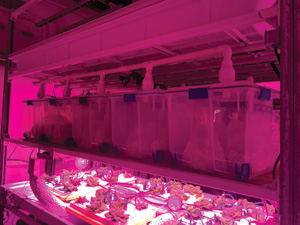
Research projects can at times lead to unanticipated results. While working to identify an alternative and sustainable source of carbon dioxide generation for enriching plant chambers within the growing vertical farming industry as a graduate student at the University of Arizona, Justin Chung discovered the potential benefits for sustaining astronauts in long duration missions. Chung studied linking specialty mushroom cultivation chambers with plant cultivation chambers via air exchange, with the idea that CO2 respiration from the mycelium during incubation could enrich leafy plants during photosynthesis. His research focused on which specific species, substrates, and environmental conditions would be ideal for urban agriculture.
Photo: Mushroom cultivation chambers produce carbon dioxide that can be used for plant growth. By Justin Chung
Project GW20-210 Read more about this project
The Terroir of Bison
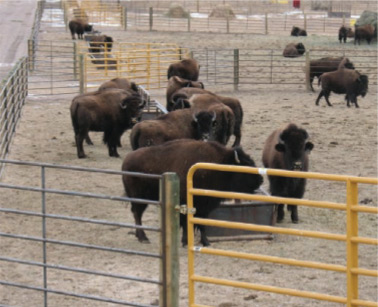
The Terroir of Bison: Is Grass-Fed Bison Better for your Health?
As with other livestock, it stands to reason that how and where bison are raised would impact the meat’s nutritional profile. But there isn’t much science on how different forages and finishing strategies effect bison quality. Nutrition science graduate student Joseph Vinod Varre and Professor Stephan van Vliet at Utah State University are taking an innovative look at the nutritional composition of bison raised and finished at three ranches in the West. Their research could inform consumers and ranchers as they navigate the health and environmental benefits of this popular, growing industry.
Project GW24-010 Read more about this project
Photo: Most bison sold in the United States are finished in penned feed lots. Courtesy of the Turner Institute of Ecoagriculture.
Ecology of Fear to Protect Chile
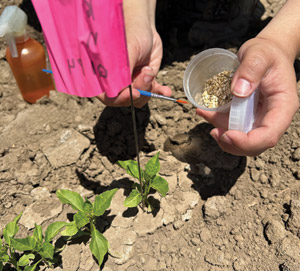
Studying the Ecology of Fear to Protect Chile in Colorado
Tiny aphids are causing outsized losses for chile pepper growers in Colorado, even though the insects don’t feed on that particular crop and don’t linger in it. Aphids pick up the alfalfa mosaic virus feeding on alfalfa, then transmit it to pepper plants by probing and poking the plants. That behavior makes pesticides ineffective. It also makes traditional biocontrol difficult. Graduate student at Colorado State Lara Amiri-Kazaz received a grant to “explore the consumptive and non-consumptive effects of predators of aphids.” The project looks at whether a generalist insect predator like minute pirate bugs can control aphids in chile pepper by either eating them or scaring them away.
Project GW24-004 Read more about this project
Photo:: Placing minute pirate bugs on pepper plants with a paint brush. By Archie Walker
Eradicating Pale Cyst Nematode
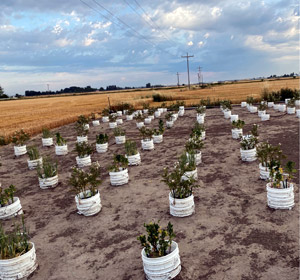
Idaho Student Researchers Work to Eradicate Pale Cyst Nematode
The pale cyst nematode, which can devastate a potato crop, is a regulated quarantine pest. The Idaho infestation is found within a nine-mile radius and phytosanitary measures to contain the infestation are in place and an eradication program is ongoing. In the quarantine area, potatoes cannot be grown in infested fields, and equipment leaving those fields must be sanitized. Eradication and deregulation of infested fields is the ultimate goal, and University of Idaho researchers, including graduate students Paige Hickman, Lindsay Schulz and Bhupendra Bhatta are at the forefront of research to find and develop strategies in support of the eradication efforts.
Projects GW21-222, GW23-256, GW24-012 Read more about this project
Photo: Litchi tomato and quinoa are both effective trap crops to reduce nematode populations. By Paige Hickman
Biofertilizers in High-Elevation Meadows
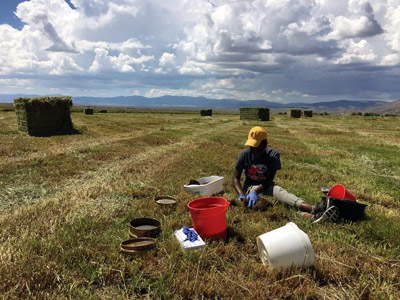
Microbial inoculants, or biofertilizers, containing living microorganisms, stimulate microbial activity and improve mobility of nutrients in soil. They are potentially useful for enhancing plant growth, increasing forage yield, and enhancing soil health. In response to producers’ concerns, University of Wyoming graduate student Rael Otuya is studying the impact of biofertilization or the use of microbial inoculants on soil health, forage quantity, and quality in hay meadows. If the potential of applying microbial inoculants proves successful, producers may be able to reduce reliance on chemical fertilizers, reduce costs, optimize yields, foster carbon sequestration, and promote soil health.
Project GW24-015 Read more about this project
Photo: Rael Otuya collects soil samples to measure biofertilizer effects in Wyoming. By Daniel McCrae Adamson
Managing Invasive Grasses

A New Tool for Managing Invasive Grasses in Montana
Invasive annual grasses are reducing the abundance of native grasses that livestock producers depend on for sustainable forage production in the semi-arid rangelands of southwestern Montana. At the current low-to-moderate levels of invasion, it’s crucial to begin targeted management before invasive populations become too advanced. To guide their efforts to slow or halt annual grass expansion, producers have expressed a desire for new and affordable tools.Montana State University graduate student Erin Teichroew’s project aims to improve understanding of how Nutrafix, a commercially available amendment, affects seed germination and establishment of native and non-native species, as well as its broader impact on forage quality and soil health.
Project GW24-011 Read more about this project
Photo: A field site in Montana where a soil amendment is being tested to reduce invasive weeds. By Erin Teichroew